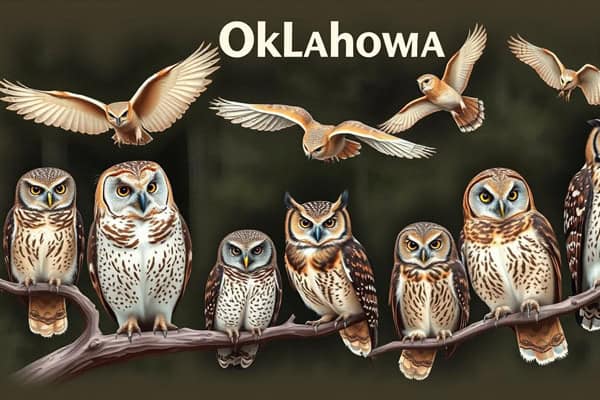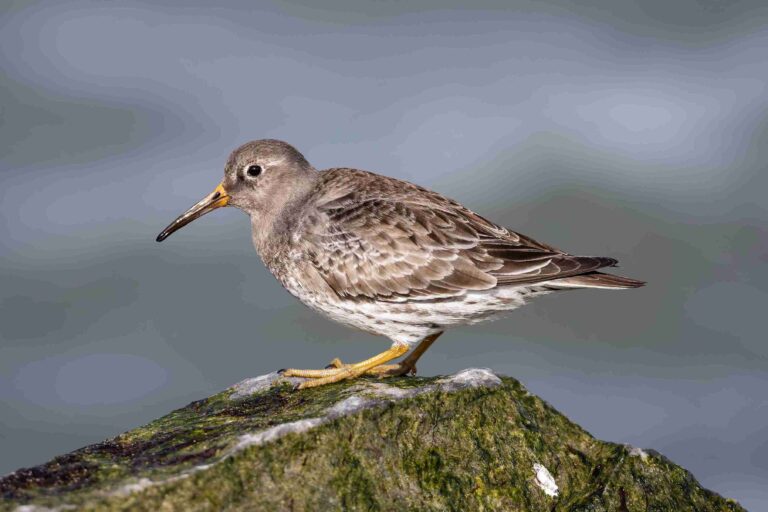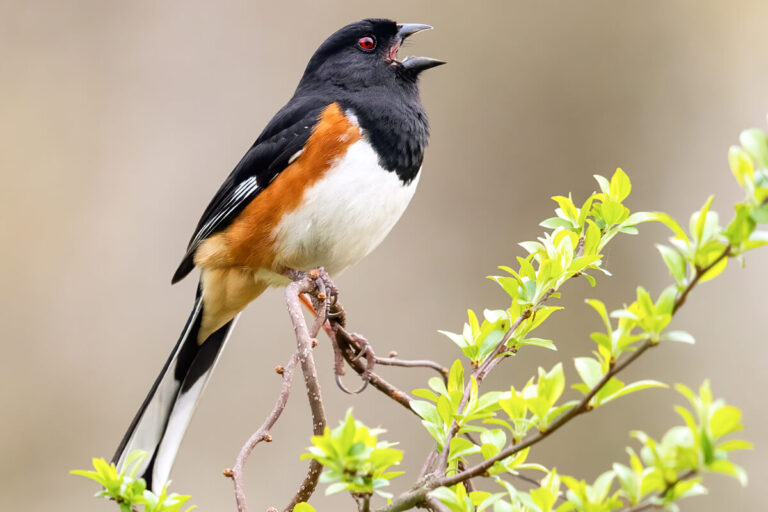Top 9 Types of Owls Species in Oklahoma (With Photos)
Did you know over 19 owls live in Oklahoma? These nocturnal birds are vital to our ecosystem. They have unique adaptations for different habitats in the state.
We’ll look at the owl types in Oklahoma. We’ll talk about their behaviors, where they live, and the challenges they face. This will help us understand why we need to protect them.
Let’s explore Oklahoma’s wildlife, focusing on these amazing owls. We’ll see how important their habitats are for our ecosystem. We’ll also discuss why we need to keep working to protect these birds.
1. Barn Owl
- Scientific name – Tyto alba
- Lifespan – 25 years (captivity: maximum recorded)
- Size – 13 -15 in
- Weight – 8 – 25 oz
- Wingspan – 31 – 37 in
In Oklahoma, the Barn Owl is a standout among wildlife species. It’s known for its unique look and hunting prowess. Let’s explore how to identify this owl, where it lives, and its hunting ways.

Appearance and Identification
The Barn Owl has a heart-shaped face that boosts its hearing. This makes it a top hunter at night. Its feathers mix white and brown, blending well with farmlands and grasslands. Long wings and a thin body let it fly quietly, helping it sneak up on prey.
Habitat and Range
Barn Owls live in open areas of Oklahoma, like farmlands, grasslands, and old buildings. They like these places because they have lots of small mammals to eat. This shows how well they adapt to different places in the state.
Diet and Hunting Behavior
Barn Owls mainly eat rodents, like voles and mice. Their hunting is quite interesting. They use their great hearing to find prey in the dark. Their silent flight lets them get close to animals without being seen, making them very good hunters.
2. Great Horned Owl
- Scientific name – Bubo virginianus
- Lifespan – 28 (maximum recorded)
- Size – 17 – 25 in
- Weight – 2.6 – 3.5 lb
- Wingspan – 3 – 5 ft
The Great Horned Owl is a top raptor in Oklahoma’s diverse landscapes. It’s a symbol of Oklahoma’s wildlife. We’ll explore its features, nesting, and communication.
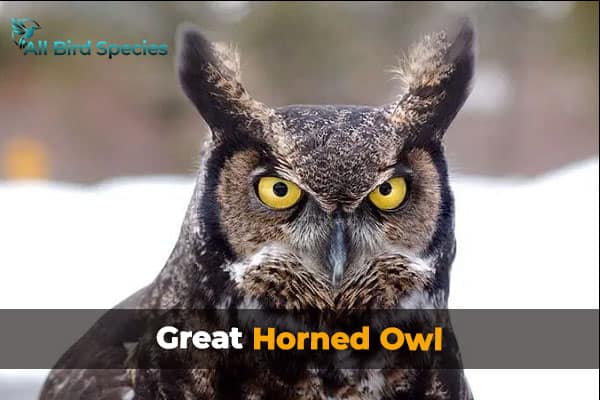
Physical Characteristics
The Great Horned Owl is easy to spot with its unique tufts and stout body. Its yellow eyes and detailed feathers make it look regal. Adults are 18 to 25 inches tall and can spread up to 5.6 feet wide, making them big owls in North America.
Nesting Habits
Great Horned Owls like to take over nests from other birds, like hawks or crows. They live in many places, from cities to deep forests. They pick high spots for their nests to keep their babies safe.
Behavior and Communication
Great Horned Owls change their behavior with the seasons and their environment. They start their courtship in late winter with fancy displays. They use different calls, from deep hoots to soft coos, to talk to each other. These calls help them show who’s boss and find mates.
Learning about the Great Horned Owl helps us understand ecosystems and why we should protect their homes. Seeing these amazing birds in action makes us appreciate Oklahoma’s wildlife more.
3. Barred Owl
- Scientific name – Strix varia
- Lifespan – 24 years (oldest recorded)
- Size – 16 – 25 in
- Weight – 17 – 35 oz
- Wingspan – 38 -49 in
The Barred Owl is a standout in Oklahoma’s bird world. It’s known for its haunting hooting calls. This bird has traits that make it popular among bird watchers and researchers. Learning about the Barred Owl can deepen our respect for its role in our ecosystem, especially in forests.
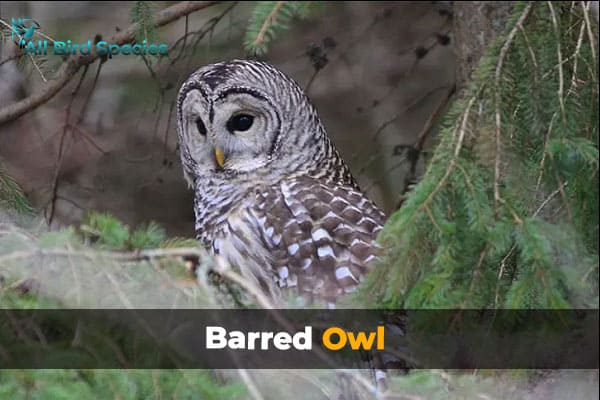
Identification Features
It’s easy to spot the Barred Owl with its unique look. They have brown and white striped feathers that help them hide in the forest. Their round face and dark eyes, framed by a pale facial disc, make them stand out. Their feathers not only help them hide but also make them a beautiful sight in nature.
Preferred Habitats
Barred Owls love mature forests, often near water like rivers or lakes. These forests offer them shelter and plenty of food, like small mammals, birds, and amphibians. Their smart choices in where to live make them a key part of Oklahoma’s owl species.
4. Eastern Screech Owl
- Scientific name: Megascops asio
- Life span: 8 to 10 years
- Size: 16 to 25 cm (6.5 to 10 in)
- Weight: 121 to 244 g (4.25 to 8.5 oz)
- Wingspan: 46 to 61 cm (18 to 24 in)
The Eastern Screech Owl is small but fascinating. It has unique colors that help it blend in. These colors make it hard to spot, even for bird lovers.

Distinctive Color Variants
These owls come in two main colors:
- Gray phase: It looks more muted, fitting right in with tree bark.
- Reddish-brown phase: Its warm colors help it hide among autumn leaves and branches.
These colors help them survive and show how adaptable they are to different places.
Behavioral Traits
Eastern Screech Owls have some interesting behaviors:
- They are mostly active at night and stay hidden during the day to avoid predators.
- They make sounds at night to mark their territory.
- They can freeze or act in ways that help them stay hidden when they sense danger.
Learning about their behavior and colors helps us appreciate these amazing birds more.
5. Western Screech Owl
- Scientific name – Megascops kennicottii
- Lifespan – 8 years (average)
- Size – 7.5 to 9.8 in
- Weight – 3.5 to 10.8 oz
- Wingspan – 21.6 to 24.4 in
The Western Screech Owl often stays in the shadow of its Eastern cousin. Yet, it has its own unique traits. These differences show how adaptable and resilient it is in tough environments.

Differences from Eastern Screech Owl
When we look at their habitats, we see big differences. The Western Screech Owl is smaller and has duller colors, like gray or brown. This is different from the Eastern Screech Owl’s bright red and gray colors. Their sounds also vary, with the Western one having a softer hoot.
Common Habitats
Western Screech Owls live in dry areas, like open woods, scrub forests, and cities. They like to nest in tree holes, just like their Eastern cousins. But they can live in drier places better. These owls are good at living near cities, showing they can adapt well.
| Feature | Western Screech Owl | Eastern Screech Owl |
|---|---|---|
| Size | Smaller | Larger |
| Color | Grayish to brownish | Red and gray morphs |
| Call | Softer, mellow hoot | More pronounced, varied hoots |
| Preferred Habitat | Open woodlands, scrub forests, urban areas | Diverse forests, suburban areas |
| Nesting | Cavities in trees | Cavities in trees |
6. Burrowing Owl
- Scientific name – Athene cunicularia
- Lifespan – 6 years (average)
- Size – 7.5 to 9.8 in
- Weight – 4.9 to 8.5 oz
- Wingspan – 20.1 to 24 in
The Burrowing Owls of Oklahoma are special because they live in underground burrows. This way of living helps it survive and affects how it acts with others. Let’s see how these interesting birds live in the ground and what makes them different from other owls.
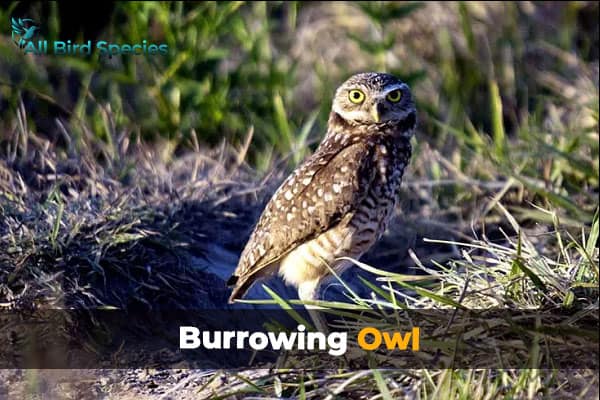
Identification and Habitat
Burrowing Owls are small, with long legs and white eyebrows that make them look curious. They have brown and white feathers that help them blend into their dry, grassy homes. They like living in open places like prairies and savannas, where they can dig or use old burrows.
Social Structure and Behavior
Burrowing Owls are not alone like many other owls. They live together in groups. They share burrows, which helps them stay safe and take care of their young. They eat insects and small mammals, showing how well they adapt to find food. Their special ways of living on the ground and their social life show how complex their communities are.
7. Long-Eared Owl
The Long-Eared Owl is a favorite among bird lovers for its unique look and secretive ways. It’s known for its long ear tufts and golden eyes. Seeing these owls in the wild lets us learn about their lives and habits.

Physical Description
The Long-Eared Owls in Oklahoma have a mottled coat that helps them blend into the woods. Its long ear tufts make it stand out, even when it tries to hide. It’s about 13 to 18 inches long and has a 35-inch wingspan. Its looks and adaptations help it survive in the wild.
Nearly Nocturnal Lifestyle
These owls are mostly active at night. They hunt in the twilight hours and hide during the day. They roost in thick foliage to stay hidden. Their main prey is small mammals, which they find using their sharp hearing. Watching them at night shows us a world that comes alive after dark.
8. Short-Eared Owl
- Scientific name:Asio flammeus
- Lifespan:12 years (maximum recorded)
- Size:13.4 to 16.9 in
- Weight:7.3 to 16.8 oz
- Wingspan:33.5 to 40.5 in
The Short-Eared Owl lives in open grasslands and prairies. It has feathers that help it blend in. We’ll look at its hunting ways and how it moves.
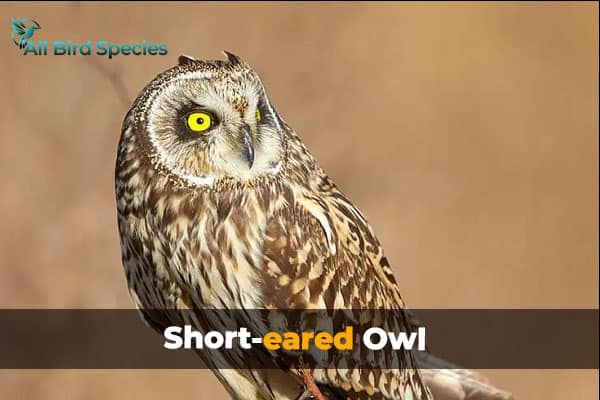
Camouflage and Hunting Strategy
The Short-Eared Owls in Oklahoma have amazing hunting skills. It uses great vision and camouflage to hide. It hunts in low light, flying close to the ground to catch small mammals. It surprises its prey by staying hidden until the last second.
Its hunting tactics include:
- Low, gliding flight
- Using the terrain for cover
- Hunting during dusk and dawn
Migration Patterns
The Short-Eared Owl moves with the seasons. It goes south in winter to find better weather. Here are some things about its migration:
- Short to moderate distances, depending on food availability
- Timing often aligned with prey populations
- Return to breeding grounds in early spring
Check Our Previous Articles:
| Black Birds In Florida |
| Hawks in New Jersey |
| Rodrigues Solitaire |
| Owls in Virginia |
| Splendid Birds With Hair |
Conservation Status of Owls in Oklahoma
Owls are crucial to our ecosystem, but they face many threats. These threats highlight the need for protecting wildlife and conservation efforts in Oklahoma. Factors like habitat loss, climate change, and human actions have hurt owl populations a lot.
Threats to Owl Populations
The main threats to owls in Oklahoma are:
- Habitat Loss: Cities and farms take over their natural homes.
- Climate Change: Changes in weather make it hard for owls to find food and breed.
- Human Interference: Owls often get hit by cars and are bothered by people.
Conservation Efforts in Place
Many are working to protect owls because they know how important it is:
- Habitat Restoration: Projects aim to bring back natural habitats for owls.
- Legislation and Policies: Laws protect owls and their homes.
- Community Engagement: Groups spread the word and offer ways for people to help.
| Threats to Owls | Impact | Conservation Action |
|---|---|---|
| Habitat Loss | Less places to nest and hunt | Restoring habitats |
| Climate Change | Changes their breeding times | Studying and watching their habits |
| Human Interference | More owls die | Spreading awareness and safety steps |
Conclusion
As we finish our look at Oklahoma’s owl species, it’s clear owls are key to our ecosystems. We’ve seen how different owls like the Barn Owl and the Great Horned Owl adapt and behave. Their roles in keeping local wildlife balanced are vital.
It’s also important to understand how to protect these amazing birds. Many of their homes are in danger. By helping conservation efforts, we help these species and our natural world. This is key for a community that values Oklahoma’s wildlife.

